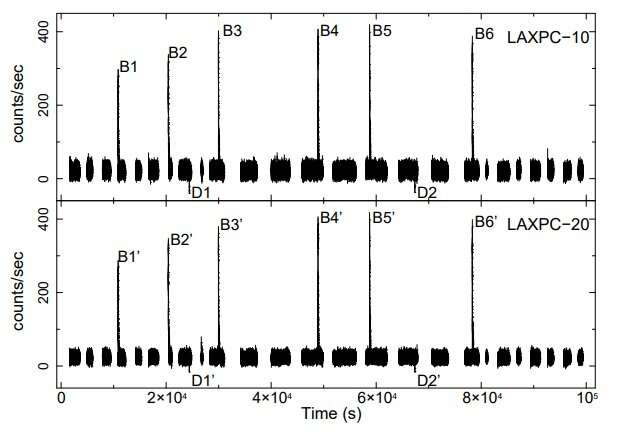February 26, 2020 report
Thermonuclear X-ray bursts and dips detected from the X-ray binary 4U 1323-62

Using the AstroSat satellite, astronomers have investigated a low-mass X-ray binary (LMXB) known as 4U 1323-62, reporting the detection of thermonuclear X-ray bursts and dips from the source. The discovery was presented in a paper published February 19 on the arXiv pre-print repository.
X-ray binaries consist of a normal star or a white dwarf transferring mass onto a compact a neutron star or a black hole. Based on the mass of the companion star, astronomers divide them into low-mass X-ray binaries (LMXB) and high-mass X-ray binaries (HMXB).
Some LMXBs exhibit transient outbursts, during which an increase in X-ray luminosities is observed. When these outbursts are characterized as Type I X-ray bursts—thermonuclear explosions taking place on the surface layers of neutron stars—they obviously confirm the presence of neutron stars in such binaries.
4U 1323-62 is a faint LMXB assumed to be located between 32,000 and 75,000 light years away from the sun. The binary is known to exhibit regular Type I X-ray bursts and periodic intensity dips in its light curve.
New observations of 4U 1323-62 conducted by Indian astronomers led by Yashpal Bhulla of the Pacific Academy of Higher Education and Research University in India, confirm that such events are still taking place in this system. Using the Large Area X-ray Proportional Counter (LAXPC) instrument onboard AstroSat, they have detected another thermonuclear X-ray bursts and dips from this source.
"We present the analysis of the AstroSat/LAXPC observation of the neutron star 4U 1323-62. LAXPC's payload detected six thermonuclear X-ray bursts and two dips from the source," the paper reads.
According to the study, the bursts were detected up to 20 keV and their recurrence time was found to be in accordance with the orbital period of the source, estimated to be around 2.7 hours. Each burst has an exposure time (rising and decay time) between 75 and 100 seconds and a high peak count rate of about 380 count/second. The researchers report a strong energy dependence of burst decay times, suggesting the cooling of burning ashes.
"The observations of 4U 1323-62 were carried out during the performance verification phase of the AstroSat satellite showed six thermonuclear X-ray bursts in a total effective exposure of about 49.5 ks for about two consecutive days," the astronomers wrote in the paper.
Data from LAXPC observations clearly show two intensity dips in the 3-20 keV energy range. The were identified when the count rate dropped significantly two times during the monitoring of 4U 1323-62.
The study also detected a low frequency quasi-periodic oscillation (LFQPO) at a frequency of approximately 1.0 Hz. The astronomers explained that such oscillation confirm that 4U 1323-62 is a high inclination system. They noted that the occurrence of QPOs could be due to the physical and geometric change in the accretion disk.
More information: Detection of the thermonuclear X-ray bursts and dips from the X-ray binary 4U 1323-62 with AstroSat/LAXPC, arXiv:2002.08140 [astro-ph.HE] arxiv.org/abs/2002.08140
© 2020 Science X Network





















